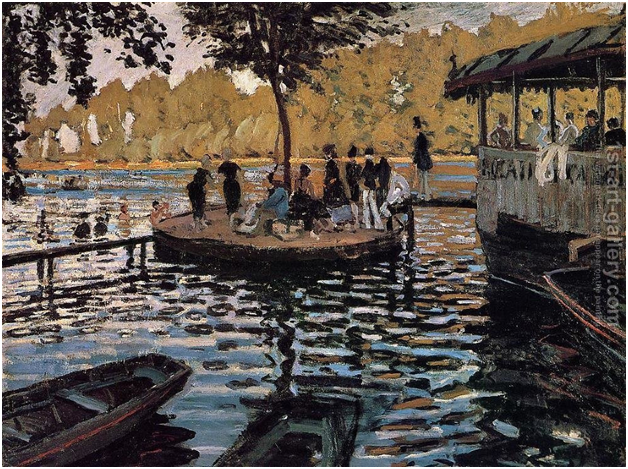Claude Oscar Monet Beautiful Palette and Technique
“I am following nature without being able to grasp her, I perhaps owe having become a painter to flowers.”
Claude Oscar Monet was one of the most influential French artists of not only his time but for many following generations as well. He was born in Paris on November 14, 1840, and was the leading member of the French Impressionist school, eventually becoming a symbol and mark of Impressionism.

Monet’s paintings attempted to capture the fleeting moments of life that sometimes ran deep and other times, passed away expeditiously. His use of colors and light was visible at the forefront and aimed to grasp the changing movements so as to cover a span of time. His loose brush strokes, vivacious compositions, and elusive nuances of nature became a benchmark in artistic history.
Colors in Monet’s Palette

Monet had a limited color palette, but that didn’t stop his paintings from being diverse. In his book Paint Like Monet, James Heard pointed out nine colors that Monet’s paintings embraced; cadmium yellow, cobalt blue, french ultramarine, viridian green, vermilion, lead white, crimson, emerald green, and ivory black (which vanished by 1886).
His use of colors depended primarily on the time of day that he was intending to paint. The nighttime was painted with dark and grey colors on vigorous backgrounds while the daytime had lights sparkling with flamboyant paints.
He often worked with oil paints, but pastels often accompanied his palette. He preferred to use light colors as his base and rejected the conventional tendency of using dark colors as primers. His Impression, Sunrise (1872) holds true to this.
Monet’s Unique Brush Stroke

Monet’s canvasses were filled with speedy and precise brushstrokes that imprisoned light in ways never seen before realism. He added large masses of vibrant and light colors, followed by strokes of pure colors covering them to further beautify the original masses of paint. This technique was named ‘visual mixing.’
Monet was known to possess a large flat filbert tipped brush and instead of mixing the colors together, he applied the paint side by side to present a vibrant texture surface. His strokes intended to capture light instead of the objects, and even though his paintings were laced with heavy strokes of paint to manifest them into opaque textures like in his Red Water Lilies, it was never exploited or undervalued.
A Painter of Light

Despite numerous criticisms, Monet never backed away from portraying fleeting glimpses of passing light on landscapes and gardens. His impressions contained both; a sunlit flower on an autumn afternoon and a shadowed moon basked in water. In one of his letters, Monet expressed how he was “appalled by the colors” and found the light “simply terrifying.”
His use of light encapsulated everything, from the petrifying downpour of rain to the changeability of the sky. He liked to paint on pale and light-colored canvases which could highlight his opaque and vital points. The illustrations were done in successions at regular intervals in various magazines, where he captured the same subject and the changes that it underwent. And what better example of this than The Woman in the Garden?
Father of Impressionism

“I would like to paint the way a bird sings,” perhaps encompass Monet’s impressionism perfectly. View at Rouelles, Le Havre was one of the first Monet paintings, completed in 1858, which had its roots in realism.
He wasn’t the first one to use the style of impressionism. Nevertheless, he became the most famous impressionist painter. His paintings showed images of bridges, humans, landscapes, flowers, and a variety of outdoor scenes that were painted in a way to represent and embody its reality and naturalness.
His paintings did not only create an impression of a landscape or a flower, it encapsulated its sensation, its undying emotion. His ingenious depiction of the world becomes an inspiration for other impressionist artists that surfaced during and after his time. Battling all the criticism that came his way for his style of painting, Monet not only started a movement, but he himself became one.
Conclusion
The quintessential French movement saw many key figures and artists. But Claude Oscar Monet was the one who became history. His dedication and persistence towards his art as well as his perseverance and acceptance of the criticisms he faced, allowed him to reach the pinnacle of artistic heights.
https://www.1st-art-gallery.com/ is not only home to the dynamic collection of Monet’s artworks, but is also the world’s largest supplier of Made-to-Order Oil Paintings! And their journey to your walls is just a few clicks away. Just as Monet’s love for nature and art became a touchstone that is inspiring the world even today, let your love for the talent of art inspire you as well.
Sanju kmr
Latest posts by Sanju kmr (see all)
- The Vital Importance of Professional Plumbing Services - April 15, 2024
- Transforming Your Outdoor Oasis: The Ultimate Guide to Using Decorative Stones for Landscaping - February 1, 2024
- Sofa Cum Beds: Stylish and Functional Furniture Solutions - January 5, 2024
